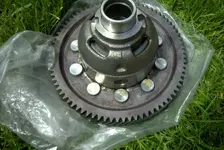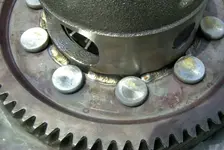first of all I am no expert and never claimed to be. If I posted something wrong please point it out and I'll remove anything erroneous from my posts...
but in support of what I put up already:
Well I looked around and I haven't found a torque preset for the quaife.
Also
as far as I know the quaife is a purely mechanical gear based Torsen differential:
The
Torsen differential* is a purely mechanical device; it has no electronics, clutches or viscous fluids.
The Torsen (from
Torque
Sensing) works as an open differential when the amount of torque going to each wheel is equal. As soon as one wheel starts to lose traction, the difference in torque causes the gears in the Torsen differential to bind together. The design of the gears in the differential determines the
torque bias ratio. For instance, if a particular Torsen differential is designed with a 5:1 bias ratio, it is capable of applying up to five times more torque to the wheel that has good traction.
<TABLE cellSpacing=0 cellPadding=3 width=200 align=right bgColor=lightyellow border=1><TBODY><TR><TD><CENTER>
Hummer!</CENTER>[size=-1]The HMMVV, or Hummer, uses Torsen differentials on the front and rear axles. The owner's manual for the Hummer proposes a novel solution to the problem of one wheel coming off the ground: Apply the
brakes. By applying the brakes, torque is applied to the wheel that is in the air, and then five times that torque can go to the wheel with good traction.[/size]
</TD></TR></TBODY></TABLE>These devices are often used in high-performance all-wheel-drive vehicles. Like the viscous coupling, they are often used to transfer power between the front and rear wheels. In this application, the Torsen is superior to the viscous coupling because it transfers torque to the stable wheels before the actual slipping occurs. However, if one set of wheels loses traction completely, the Torsen differential will be unable to supply any torque to the other set of wheels. The bias ratio determines how much torque can be transferred, and five times zero is zero.
A wheel can only support so much power to it...
Who has heard an MSP make any noise? Shawn from mazdaformance has said repeatedly on the phone and I wouldn't be surprised if he has said on the forum that he hears the quaife. You've heard it in your car too. So I don't understand the issue there.
As far as the MSP diff...
Here's it's specs:
Super LSD by Tochigi Fuji Sangyo KK, conical ring torque sensing type Torque Bias Ratio: 2.0 / Preset Torque 49 Nm
From:
http://www.avantemazda.com/www2/mazdaspeed.html
Showing the preset torque that I'm talking about that gets it around the 0 Torque condition. The TFS is neither a clutch nor pure gear LSD. It's a mixture of the two.
From phantom grips own website:
Phantom Grip serves two distinctive functions in your street or race vehicle. First, it functions as a disc-type limited slip in cornering and braking. Disc plates exert pressure against spider gears using spring pressure to regulate the amount of slippage at the wheels. Helping to accelerate earlier, while exiting corners at a higher speed
And looking at the construction you can see that it is two metal plates with sprinsg in them forcing out on the spider gears...
So I question where the point of friction is out of all of this?






